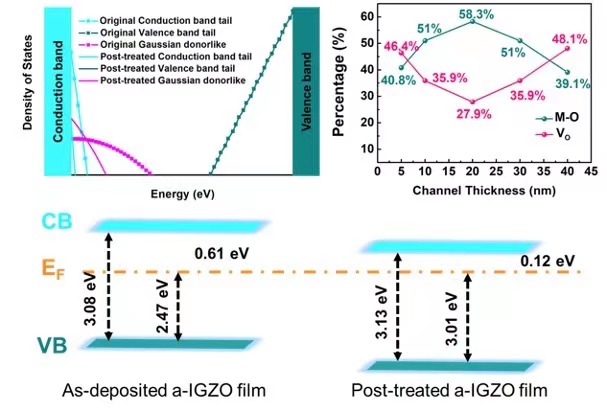Recently, Professor Zhang Min and Zhang Jiaona, the corresponding author and the first author of our research group, published the research results entitled “Analysis of Carrier Behavior for Amorphous Indium Gallium Zinc Oxide After Supercritical Carbon Dioxide Treatment” on Advanced Materials Interfaces.
In this paper, the mechanism of a-IGZO performance change before and after supercritical carbon dioxide treatment was studied for the first time. Through the design of a-IGZO film with different thickness as the channel device, the analysis shows that supercritical carbon dioxide treatment is better for the device with thin A-IGZO film. Through chemical bond characterization and simulation results, it is proved that the reason why the treatment can improve a-IGZO device is the repair of oxygen vacancy defect and the increase of carrier concentration. This work has deeply discussed the working mechanism of A-IGZO film, which makes scholars in this field have a deeper understanding of A-IGZO.
Amorphous indium gallium zinc oxide (a-IGZO) thin-film quality can be enhanced using supercritical carbon dioxide (SCCO2). How to verify specific and accurate mechanism for the carriers inside an a-IGZO layer before and after the SCCO2 treatment is worth investigating. This work designs a-IGZO thin film transistors with different channel thicknesses (41, 28, and 19 nm), treats them using SCCO2, and analyzes the change in carrier behavior. The effect of the SCCO2 on both carrier density and carrier transport is investigated using energy band information, Technology Computer Aided Design (TCAD) simulations on density of states and resistance analyses. After the treatment, the thinner channel thickness exhibits better drivability enhancement. That is because of the fewer traps and smoother carrier transportation path resulted from better M−O−M frameworks, and decreased M−OH bonds as well as interface charges. Besides the traditional analysis methods and TCAD simulations, layer-by-layer X-ray photoelectron spectroscopy and sheet resistance measurement are also applied to verify the detailed carrier mechanism behind different phenomena.
The article links:
